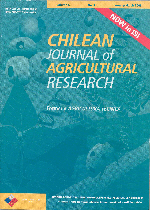
|
Agricultura Técnica
Instituto de Investigaciones Agropecuarias, INIA
ISSN: 0365-2807
EISSN: 0365-2807
Vol. 61, No. 2, 2001, pp. 151-161
|
 Bioline Code: at01018
Bioline Code: at01018
Full paper language: English
Document type: Research Article
Document available free of charge
|
|
|
Agricultura Técnica, Vol. 61, No. 2, 2001, pp. 151-161
| en |
Beef Production Using Tagasaste (Chamaecytisus Proliferus Subsp. Palmensis) and Natural Pastures in Arauco Province, Chile
Klee, Germán G.; Fraga, Alejandro S. & Canobbi, Juan Carlos V.
Abstract
The variation of the liveweight of calves grazed on Tagasaste
(
Chamaecytisus proliferus
subsp.
palmensis
) during fall-winter was studied for the first time in Chile. Sixteen Holstein
x Aberdeen Angus or Hereford bull calves, 7.5 months old and 197 kg liveweight,
were pastured on 4.6 hectares of 3 year-old tagasaste planted on natural
pasture. The following treatments were studied during fall-winter season:
a) Tagasaste grazing (T), and b) Tagasaste grazing plus 2 kg of oats calf/day
(TA). In the spring and summer, all yearling steers grazed 6 ha of natural
damp pasture consisting of berry clover (
Trifolium fragiferum
) and grass. The evaluation included availability and chemical composition
of forage, variation of liveweight and carcass weight. The winter liveweight
gains of the bull calves grazing on tagasaste reached 0.38 kg/bull calf/day.
This value increased to 0.72 kg/ bull calf/day with the addition of oats.
In the animals grazing spring and summer damp natural pasture, the daily
liveweight gains were 0.9 and 1.1 kg/yearling steer for T and TA, respectively.
The steers finished with 428 and 444 kg of liveweight at 17 months age and
the liveweight production per ha reached 348.6 and 371.3 kg in T and TA,
respectively. The carcass parameters did not differ significantly (P≥0.05),
however, the difference in carcass fat was significant at P≤0.1,
which is an important economic consideration. It is concluded that tagasaste
is an acceptable resource for autumn and winter grazing.
Keywords
Prunus persica , maturity, firmness.
|
| |
| pt |
Producción de Carne Bovina Utilizando Tagasaste (Chamaecytisus Proliferus Subsp. Palmensis) y Praderas Naturales en la Provincia de Arauco, Chile.
Klee, Germán G.; Fraga, Alejandro S. & Canobbi, Juan Carlos V.
Resumo
El experimento tuvo como objetivo evaluar las variaciones
de peso vivo (PV) de terneros en pastoreo otoño-invierno de tagasaste
(
Chamaecytisus proliferus
subsp.
palmensis
), establecido sobre pradera natural, y estudiar el efecto al suplementar
estos forrajes con avena grano. Se usaron 16 terneros enteros mestizos Holandés
Europeo x Aberdeen Angus o Hereford, de 7,5 meses de edad y 197 kg de PV,
los que pastorearon en 4,6 ha de tagasaste de 3 años de edad, plantados
sobre pradera natural. Se estudiaron durante el invierno los tratamientos:
a) Pastoreo de tagasaste (T), y b) Pastoreo de tagasaste más 2 kg diarios
de avena grano/animal (TA). En primavera-verano todos los novillos pastorearon
6 ha de pradera natural de vega de trébol frutilla (
Trifolium fragiferum
) y gramíneas. Se evaluaron la disponibilidad y composición química
del forraje, variaciones de PV y características de las canales. Los
terneros que pastorearon tagasaste alcanzaron ganancias invernales diarias
de 0,39 kg/animal, valor que aumentó a 0,72 kg/animal en terneros suplementados
con avena. Las ganancias diarias en praderas naturales de vega fluctuaron
entre 1,1 y 0,9 kg/animal para T y TA, para el ensayo de primavera-verano,
respectivamente. Los animales finalizaron con 444 y 428 kg PV a los 17 meses
de edad, y la producción anual de PV por hectárea alcanzó
a 349 y 371 kg en los tratamientos T y TA, respectivamente. Las características
de las canales no difirieron significativamente (P≥0,05), sin embargo
la diferencia de la grasa de cobertura fue significativa (P≤0,10),
aspecto importante de considerar en la evaluación económica de
los tratamientos.
Palavras-chave
Prunus Persica , maduración, firmeza
|
| |
© Copyright 2001 - Instituto de Investigaciones Agropecuarias, INIA (Chile)
Alternative site location: http://www.inia.cl/at/agritec.htm
|
|
